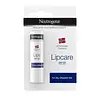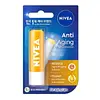Neutrogena Norwegian Formula Lipcare SPF 20 Versus Nivea Anti Aging & Sun Protection SPF 30 Lip Care
What's inside
What's inside
 Key Ingredients
Key Ingredients

 Benefits
Benefits

 Concerns
Concerns

 Ingredients Side-by-side
Ingredients Side-by-side

Ricinus Communis Seed Oil
MaskingParaffin
PerfumingCera Alba
EmollientEthylhexyl Methoxycinnamate
UV AbsorberIsodecyl Neopentanoate
EmollientIsopropyl Myristate
EmollientCetyl Palmitate
EmollientCetearyl Alcohol
EmollientButyl Methoxydibenzoylmethane
UV AbsorberCetyl Alcohol
EmollientCera Microcristallina
Emulsion StabilisingVp/Eicosene Copolymer
Isohexadecane
EmollientBisabolol
MaskingPropylene Glycol
HumectantStearic Acid
CleansingPalmitic Acid
EmollientSodium Cetearyl Sulfate
CleansingCandelilla Cera
EmollientCitric Acid
BufferingDisodium Phosphate
BufferingPotassium Phosphate
BufferingBHT
AntioxidantParfum
MaskingCI 77891
Cosmetic ColorantRicinus Communis Seed Oil, Paraffin, Cera Alba, Ethylhexyl Methoxycinnamate, Isodecyl Neopentanoate, Isopropyl Myristate, Cetyl Palmitate, Cetearyl Alcohol, Butyl Methoxydibenzoylmethane, Cetyl Alcohol, Cera Microcristallina, Vp/Eicosene Copolymer, Isohexadecane, Bisabolol, Propylene Glycol, Stearic Acid, Palmitic Acid, Sodium Cetearyl Sulfate, Candelilla Cera, Citric Acid, Disodium Phosphate, Potassium Phosphate, BHT, Parfum, CI 77891
Octyldodecanol
EmollientRicinus Communis Seed Oil
MaskingHydrogenated Rapeseed Oil
EmollientBeeswax
Emulsion StabilisingHomosalate
Skin ConditioningOctocrylene
UV AbsorberCetyl Palmitate
EmollientButyl Methoxydibenzoylmethane
UV AbsorberEthylhexyl Salicylate
UV AbsorberCetyl Ricinoleate
EmollientBis-Diglyceryl Polyacyladipate-2
EmollientCetearyl Alcohol
EmollientButyrospermum Parkii Butter
Skin ConditioningPersea Gratissima Oil
Skin ConditioningSimmondsia Chinensis Seed Oil
EmollientTocopheryl Acetate
AntioxidantBHT
AntioxidantParfum
MaskingCI 77891
Cosmetic ColorantCI 77492
Cosmetic ColorantOctyldodecanol, Ricinus Communis Seed Oil, Hydrogenated Rapeseed Oil, Beeswax, Homosalate, Octocrylene, Cetyl Palmitate, Butyl Methoxydibenzoylmethane, Ethylhexyl Salicylate, Cetyl Ricinoleate, Bis-Diglyceryl Polyacyladipate-2, Cetearyl Alcohol, Butyrospermum Parkii Butter, Persea Gratissima Oil, Simmondsia Chinensis Seed Oil, Tocopheryl Acetate, BHT, Parfum, CI 77891, CI 77492
 Reviews
Reviews

Ingredients Explained
These ingredients are found in both products.
Ingredients higher up in an ingredient list are typically present in a larger amount.
BHT is a synthetic antioxidant and preservative.
As an antioxidant, it helps your body fight off free-radicals. Free-radicals are molecules that may damage your skin cells.
As a preservative, it is used to stabilize products and prevent them from degrading. Specifically, BHT prevents degradation from oxidation.
The concerns related to BHT come from oral studies; this ingredient is currently allowed for use by both the FDA and EU.
However, it was recently restricted for use in the UK as of April 2024.
Learn more about BHTAlso known as Avobenzone, this ingredient is a chemical sunscreen filter that provides protection in the UV-A range.
Avobenzone is globally approved and is the most commonly used UV-A filter in the world.
Studies have found that avobenzone becomes ineffective when exposed to UV light (it is not photostable; meaning that it breaks down in sunlight). Because of this, formulations that include avobenzone will usually contain stabilizers such as octocrylene.
However, some modern formulations (looking at you, EU!) are able to stabilize avobenzone by coating the molecules.
Avobenzone does not protect against the UV-B range, so it's important to check that the sunscreen you're using contains other UV filters that do!
The highest concentration of avobenzone permitted is 3% in the US, and 5% in the EU.
Learn more about Butyl MethoxydibenzoylmethaneCetearyl alcohol is a mixture of two fatty alcohols: cetyl alcohol and stearyl alcohol. It is mainly used as an emulsifier. Emulsifiers help prevent the separation of oils and products. Due to its composition, it can also be used to thicken a product or help create foam.
Cetearyl alcohol is an emollient. Emollients help soothe and hydrate the skin by trapping moisture.
Studies show Cetearyl alcohol is non-toxic and non-irritating. The FDA allows products labeled "alcohol-free" to have fatty alcohols.
This ingredient is usually derived from plant oils such as palm, vegetable, or coconut oils. There is debate on whether this ingredient will cause acne.
Due to the fatty acid base, this ingredient may not be Malassezia folliculitis safe.
Learn more about Cetearyl AlcoholCetyl Palmitate is a wax-like substance.
It comes from palmitic acid and palmityl alcohol. Cetyl Palmitate may not be safe for Malassezia folliculitis, or fungal-acne.
This ingredient is naturally found in the guava fruit and stony corals.
Learn more about Cetyl PalmitateCi 77891 is a white pigment from Titanium dioxide. It is naturally found in minerals such as rutile and ilmenite.
It's main function is to add a white color to cosmetics. It can also be mixed with other colors to create different shades.
Ci 77891 is commonly found in sunscreens due to its ability to block UV rays.
Learn more about CI 77891Parfum is a catch-all term for an ingredient or more that is used to give a scent to products.
Also called "fragrance", this ingredient can be a blend of hundreds of chemicals or plant oils. This means every product with "fragrance" or "parfum" in the ingredients list is a different mixture.
For instance, Habanolide is a proprietary trade name for a specific aroma chemical. When used as a fragrance ingredient in cosmetics, most aroma chemicals fall under the broad labeling category of “FRAGRANCE” or “PARFUM” according to EU and US regulations.
The term 'parfum' or 'fragrance' is not regulated in many countries. In many cases, it is up to the brand to define this term.
For instance, many brands choose to label themselves as "fragrance-free" because they are not using synthetic fragrances. However, their products may still contain ingredients such as essential oils that are considered a fragrance by INCI standards.
One example is Calendula flower extract. Calendula is an essential oil that still imparts a scent or 'fragrance'.
Depending on the blend, the ingredients in the mixture can cause allergies and sensitivities on the skin. Some ingredients that are known EU allergens include linalool and citronellol.
Parfum can also be used to mask or cover an unpleasant scent.
The bottom line is: not all fragrances/parfum/ingredients are created equally. If you are worried about fragrances, we recommend taking a closer look at an ingredient. And of course, we always recommend speaking with a professional.
Learn more about ParfumRicinus Communis Seed Oil is the INCI name for castor oil.
Castor Oil helps moisturize the skin. It is rich in a fatty acid called ricinoleic acid. This fatty acid helps prevent moisture loss on the skin. This helps keep your skin soft and hydrated. Ricinoleic acid also has anti-inflammatory and pain reducing properties.
Besides hydrating the skin, castor oil is also used to hydrate hair. By keeping the hair shaft moisturized, breakage is decreased. More studies are needed to show castor oil's effective on stimulating hair growth.
Castor oil is created by cold-pressing castor seeds and then purifying the oil with heat. It was used in Ancient Egypt as fuel in lamps and to help treat eye irritation.
The term 'fragrance' is not regulated in many countries. In many cases, it is up to the brand to define this term. For instance, many brands choose to label themselves as "fragrance-free" because they are not using synthetic fragrances. However, their products may still contain ingredients such as essential oils that are considered a fragrance.
Learn more about Ricinus Communis Seed Oil